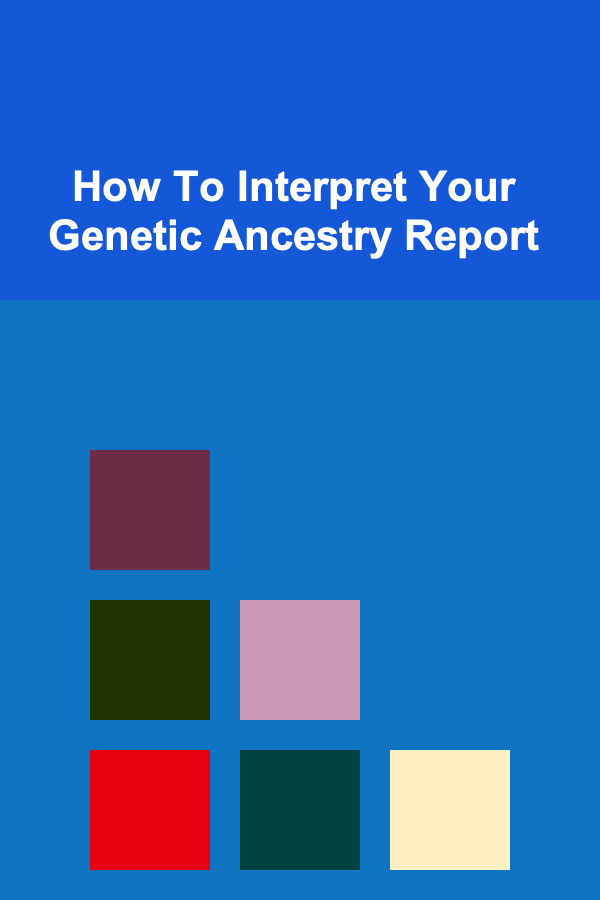
How To Interpret Your Genetic Ancestry Report
ebook include PDF & Audio bundle (Micro Guide)
$12.99$8.99
Limited Time Offer! Order within the next:

Genetic ancestry testing has become a popular tool for individuals seeking to learn more about their genetic origins. With the advent of consumer-grade DNA testing companies like 23andMe, AncestryDNA, and others, people can now trace their ancestral roots and gain insights into their ethnic background, geographical origins, and even uncover distant relatives. However, understanding your genetic ancestry report can be a complex task. It involves decoding scientific data, understanding various genetic markers, and interpreting results within a broader historical and sociocultural context. This article delves into how to interpret your genetic ancestry report, guiding you through the intricacies and helping you make the most of the information it provides.
The Basics of Genetic Ancestry Testing
Genetic ancestry testing analyzes your DNA to uncover information about your biological heritage. This is done by comparing specific segments of your DNA with reference databases that include the genetic profiles of people from various regions and ethnic groups around the world. Through this comparison, your genetic markers are matched with known genetic patterns of populations, helping to predict your ancestral origins.
DNA and Genetic Markers
Your genetic makeup is encoded in the DNA present in every cell of your body. DNA is composed of nucleotides, which are the building blocks of your genetic code. When ancestry companies analyze your DNA, they typically focus on certain regions of your genome. These regions, known as genetic markers, provide valuable information about your lineage. The markers most commonly used in ancestry testing include:
- Autosomal DNA: This type of DNA comes from all of your ancestors. It is inherited from both your mother and father and is used to trace your heritage across multiple generations. Autosomal testing gives you an overall picture of your genetic ancestry, including ethnic composition.
- Mitochondrial DNA (mtDNA): Mitochondrial DNA is passed down from mother to child. Since it follows a matrilineal lineage, mtDNA can be used to trace your maternal ancestry and is often used to study deep ancestral roots over thousands of years.
- Y-DNA: The Y chromosome is passed from father to son and is used to trace paternal ancestry. However, only males have a Y chromosome, so this marker is relevant to men only.
Reference Populations and Databases
The key to genetic ancestry testing is the comparison of your genetic markers to those in reference populations. These are groups of individuals whose genetic data has been compiled from different geographical regions and ethnic backgrounds. When testing companies collect your genetic data, they compare it to their reference databases to predict which populations you are most closely related to.
For example, if you share a significant portion of your DNA with individuals from a certain region in Africa, the ancestry company might conclude that you have African ancestry. These reference databases are continuously updated as more individuals participate in DNA testing, improving the accuracy and scope of ancestry reports.
Ancestry Composition
One of the main results you will find in your ancestry report is the "ancestry composition." This breaks down your genetic makeup into percentages that correspond to different regions or ethnic groups. For instance, you might learn that you are 40% Eastern European, 30% East Asian, and 15% Sub-Saharan African, with the remaining 15% made up of various other ethnicities.
It's important to note that these percentages are estimates based on the available reference populations. The accuracy of these estimates can vary depending on the size and diversity of the reference database used by the testing company.
Decoding Your Genetic Ancestry Report
Interpreting your genetic ancestry report requires an understanding of several components that will appear in the results. Below are some key elements you'll encounter and how to make sense of them.
1. Ethnicity Estimates
The most popular aspect of genetic ancestry reports is the ethnicity estimate. This tells you which ethnic groups or populations are most prevalent in your genetic makeup. The estimate is based on your DNA's similarity to known genetic markers from different populations around the world. However, there are several factors to keep in mind when interpreting this section:
a. Precision and Uncertainty
Ethnicity estimates are never 100% precise. The results are based on the best available data from global reference populations, which means they are still subject to change as new genetic information is discovered. Additionally, ethnicity estimates are generally presented with a margin of error. This means that you might see percentages for certain regions that add up to more than 100%, or you may see results that appear inconsistent with your family history. This is completely normal and is a reflection of the inherent complexities of genetic inheritance.
b. Regional Variability
Different testing companies may use slightly different reference populations, which can result in discrepancies in your ethnicity estimates. For example, one company might classify your ancestry as primarily from Eastern Europe, while another might emphasize your connection to Central Europe. The more diverse the reference population used in the comparison, the more nuanced and accurate the estimate is likely to be.
c. Ambiguity in Ancient Ancestry
Ancestry tests are particularly helpful for tracing recent ancestors, but they can also provide clues about more ancient heritage. In this case, it's essential to recognize that genetic markers shared by different populations from the same geographical area or continent may not always point to a specific cultural or ethnic group. For instance, the genetic markers found in modern-day Europeans are shared with various ancient populations, including early human migrations from Africa, Neanderthals, and more recent genetic influences.
2. Maternal and Paternal Lineages
If you opted for mtDNA or Y-DNA testing, your report may include insights into your maternal or paternal lineage. These sections are particularly useful for understanding the deep history of your family tree. Here's what to look for:
a. Mitochondrial DNA (mtDNA)
Your mtDNA is passed down exclusively from your mother. As a result, it reveals a direct maternal line of ancestry. This can be traced back thousands of years and is helpful in understanding ancient human migration patterns. In your report, you might find references to ancient populations or migration routes that trace your maternal line. For example, you may learn that your maternal lineage originates from the "Haplogroup H" family, which is one of the most common haplogroups in Europe, associated with populations that spread across the continent during the Neolithic era.
b. Y-DNA
For men, the Y-DNA test traces the paternal line, providing insight into the male lineage that has been passed down through the Y chromosome. This information can reveal your paternal haplogroup, which often carries ancient genetic markers from specific regions. Understanding your Y-DNA ancestry can help you uncover your paternal roots, often linking you to distant ancestors from specific ethnic groups or populations.
3. Genetic Relatives
Many genetic ancestry companies offer a service that connects you with genetic relatives based on shared DNA. This part of the report is fascinating because it allows you to potentially connect with distant relatives you may not have known existed. These relatives are typically people who share a certain percentage of DNA with you, indicating a common ancestor somewhere in your family tree.
a. Centimorgans (cM)
Genetic relatives are often categorized by the amount of DNA you share with them, typically measured in centimorgans (cM). This number represents the total length of genetic material shared between you and a relative. The higher the cM value, the closer the relationship. For example:
- 1st-degree relatives (parents, siblings) share approximately 3,400 cM.
- 2nd-degree relatives (aunts, uncles, grandparents) share approximately 1,700 cM.
- 3rd-degree relatives (first cousins) share approximately 850 cM.
While connecting with distant cousins can be exciting, it's important to verify these relationships with genealogical records or other resources, as DNA alone cannot always confirm the exact nature of a relationship.
Factors That Affect Your Ancestry Report
Several factors can influence the results of your genetic ancestry report, making interpretation a bit more complex. Understanding these factors can help you assess the accuracy and limitations of your report.
1. Limited Reference Populations
As mentioned earlier, genetic ancestry testing companies rely on reference populations to compare your DNA with. However, these populations may not cover every ethnic group or geographical region. In some cases, the reference populations may be too limited, leading to a less accurate or incomplete report. This is particularly true for less-studied populations or those from underrepresented regions of the world.
2. Genetic Inheritance and Recombination
Genetic inheritance is not always straightforward. Due to genetic recombination, which occurs during the formation of eggs and sperm, some segments of your DNA may be inherited from your ancestors in a way that doesn't necessarily align with your family history. This can make it difficult to trace certain ancestral connections, especially if you have mixed heritage from multiple regions.
3. Historical and Socioeconomic Factors
The movement of populations due to migration, war, and trade has affected the genetic makeup of various populations throughout history. Consequently, your genetic ancestry might reflect historical events that are not captured by traditional genealogical records. Additionally, the history of colonialism, slavery, and global migration has led to complex genetic exchanges that may not be reflected in historical or cultural records.
Conclusion
Interpreting your genetic ancestry report is a process that blends science with personal discovery. By understanding the various components of your DNA and how it relates to ancient populations and more recent migrations, you can gain a deeper appreciation of your family's roots. While genetic ancestry tests provide fascinating insights, they should be viewed as one piece of the puzzle, alongside genealogical research and historical context. Ultimately, the interpretation of your ancestry report offers a rich and evolving story of human migration, familial connections, and the shared history of our species.

How to Add Greenery to Your Home Without Spending a Lot
Read More
How to Create a Warm-Up and Cool-Down Zone
Read More
How to Handle Property Maintenance and Repairs Efficiently
Read More
How to Keep Your Living Room Clutter-Free and Inviting
Read More
How to Plan for Appliance Replacement and Upgrades
Read More
How to Create Unique Ceramic Texture Effects
Read MoreOther Products

How to Add Greenery to Your Home Without Spending a Lot
Read More
How to Create a Warm-Up and Cool-Down Zone
Read More
How to Handle Property Maintenance and Repairs Efficiently
Read More
How to Keep Your Living Room Clutter-Free and Inviting
Read More
How to Plan for Appliance Replacement and Upgrades
Read More